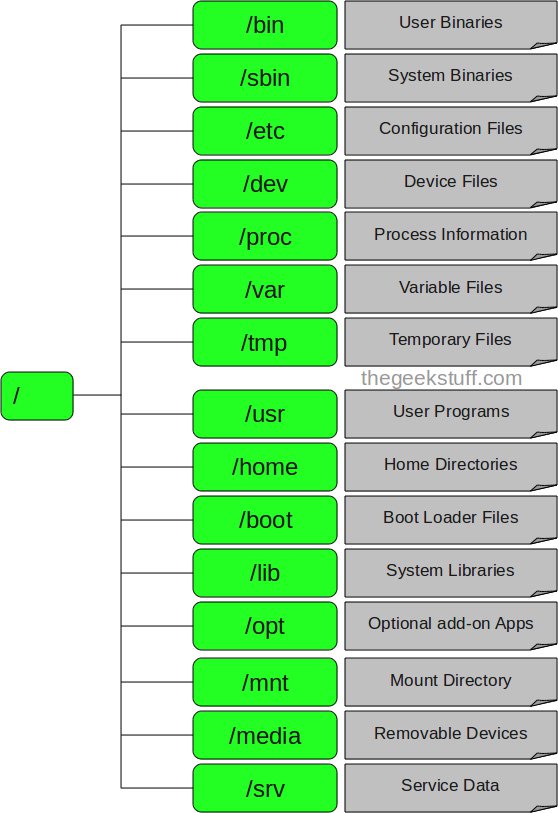Directory tree structure in Linux
TipsMake.com - Have you ever wondered why some programs in Linux are stored under different directories like / bin, / sbin, / usr / bin or / usr / sbin?
For example, some are stored in / usr / bin. Why not / bin or / sbin? What is the difference between those directories?

In this article, we will review you about Linux's file system structure and the meaning of each main directory.
1. / - Root
True to its name: the root node is the starting point of all files and directories. Only root user has permission to write in this directory. Note that / root is the root user home directory, not /.
2. / bin - User's program
This directory contains executable programs. The general Linux programs used by all users are saved here. Examples include: ps, ls, ping .
3. / sbin - System program
Just like / bin, / sbinn also contains executable programs, but they are admin programs, for system maintenance. Examples: reboot, fdisk, iptables .
4. / etc - Configuration files
This directory contains the configuration files of the programs, and it also contains shell scripts used to start or shut down other programs. For example: /etc/resolv.conf, /etc/logrolate.conf
5. / dev - Device files
Hard drive, peripheral devices such as USB drives, external drives, or any device attached to the system are stored here. For example: / dev / sdb1 is the name of the USB you just plugged into the device, to open this USB you need to use the mount command with root privileges: # mount / dev / sdb1 / tmp
6. / tmp - Temporary files
This directory contains temporary files created by the system and users. Files saved in this folder will be deleted when the system restarts.
7. / proc - Information about the process
Information about running processes will be saved in / proc as a simulated directory file system. For example, the subdirectory / proc / {pid} contains information about the process with ID as pid (pid ~ process ID). In addition, this is also the place to store information about the current resources of the system such as: / proc / version, / proc / uptime .
8. / var - File about the program variable
Information about system variables is saved in this directory. Like information about log file: / var / log, packages and databases / var / lib .
9. / usr - User's program
Contains libraries, executable files, documentation and source code for the program running at level 2 of the system. Inside
- / usr / bin contains executable files of users such as: at, awk, cc, less . If you can't find them in / bin, look in / usr / bin
- / usr / sbin contains executable files of the system under admin such as atd, cron, sshd . If you can't find them in / sbin, look in this directory.
- / usr / lib contains libraries for programs in / usr / bin and / usr / sbin
- / usr / local contains user programs installed from source. For example, if you install apache from source, it will be saved under / usr / local / apache2
10. / home - User's directory
This folder contains all the personal files of each user. For example: / home / john, / home / marie
11. / boot - Boot files
All files required when starting as initrd, vmlinux. grub is saved here. Example vmlixuz-2.6.32-24-generic
12. / lib - System library
Contains library support for executable files in / bin and / sbin. These libraries usually have names starting with ld * or lib * .so. *. For example, ld-2.11.1.so or libncurses.so.5.7
13. / opt - Optional secondary applications
This directory name means optional (optional), it contains additional applications from other independent vendors. These applications can be installed at / opt or a subdirectory of / opt
14. / mnt - Folder to mount
This is a temporary folder to mount system files. For example, # mount / dev / sda2 / mnt
15. / media - Attached devices can be removed
This temporary folder contains devices like CdRom / media / cdrom. floppy / media / floopy or / media / Data hard disk partitions (understand as D: / Data drive in Windows)
16. / srv - Data of other services
Contains data related to server services such as / srv / svs, containing CVS-related data.
 10 reasons to switch to Linux right in 2012
10 reasons to switch to Linux right in 2012 How to configure DNS Server on Ubuntu Server 11.04
How to configure DNS Server on Ubuntu Server 11.04 Instructions for installing Windows software on Linux with PlayOnLinux
Instructions for installing Windows software on Linux with PlayOnLinux Search for files and directories in Linux using the command line interface
Search for files and directories in Linux using the command line interface Instructions for creating a master partition in Ubuntu
Instructions for creating a master partition in Ubuntu How to install software and applications for Linux operating systems
How to install software and applications for Linux operating systems